Cancer incidence escalates exponentially with advancing age; however, the underlying mechanism remains unclear. In this study, we build a chronological molecular clock at single-cell transcription level with a mammary stem cell-enriched population to depict physiological aging dynamics in female mice. We find that the mammary aging process is asynchronous and progressive, initiated by an early senescence program, succeeded by an entropic late senescence program with elevated cancer associated pathways, vulnerable to cancer predisposition. The transition towards senescence program is governed by a stem cell factor Bcl11b, loss of which accelerates mammary ageing with enhanced DMBA-induced tumor formation. We have identified a drug TPCA-1 that can rejuvenate mammary cells and significantly reduce aging-related cancer incidence. Our findings establish a molecular portrait of progressive mammary cell aging and elucidate the transcriptional regulatory network bridging mammary aging and cancer predisposition, which has potential implications for the management of cancer prevalence in the aged.
© 2024. The Author(s).
Product Citations: 60
In Nature Communications on 17 June 2024 by Bai, H., Liu, X., et al.
-
Cancer Research
In EMBO Reports on 1 June 2024 by Nikolic, I., Ruiz-Garrido, I., et al.
Obesity is characterized by low-grade inflammation, energy imbalance and impaired thermogenesis. The role of regulatory T cells (Treg) in inflammation-mediated maladaptive thermogenesis is not well established. Here, we find that the p38 pathway is a key regulator of T cell-mediated adipose tissue (AT) inflammation and browning. Mice with T cells specifically lacking the p38 activators MKK3/6 are protected against diet-induced obesity, leading to an improved metabolic profile, increased browning, and enhanced thermogenesis. We identify IL-35 as a driver of adipocyte thermogenic program through the ATF2/UCP1/FGF21 pathway. IL-35 limits CD8+ T cell infiltration and inflammation in AT. Interestingly, we find that IL-35 levels are reduced in visceral fat from obese patients. Mechanistically, we demonstrate that p38 controls the expression of IL-35 in human and mouse Treg cells through mTOR pathway activation. Our findings highlight p38 signaling as a molecular orchestrator of AT T cell accumulation and function.© 2024. The Author(s).
-
Immunology and Microbiology
In Developmental Cell on 6 May 2024 by Fowler, J. L., Zheng, S. L., et al.
The developmental origin of blood-forming hematopoietic stem cells (HSCs) is a longstanding question. Here, our non-invasive genetic lineage tracing in mouse embryos pinpoints that artery endothelial cells generate HSCs. Arteries are transiently competent to generate HSCs for 2.5 days (∼E8.5-E11) but subsequently cease, delimiting a narrow time frame for HSC formation in vivo. Guided by the arterial origins of blood, we efficiently and rapidly differentiate human pluripotent stem cells (hPSCs) into posterior primitive streak, lateral mesoderm, artery endothelium, hemogenic endothelium, and >90% pure hematopoietic progenitors within 10 days. hPSC-derived hematopoietic progenitors generate T, B, NK, erythroid, and myeloid cells in vitro and, critically, express hallmark HSC transcription factors HLF and HOXA5-HOXA10, which were previously challenging to upregulate. We differentiated hPSCs into highly enriched HLF+ HOXA+ hematopoietic progenitors with near-stoichiometric efficiency by blocking formation of unwanted lineages at each differentiation step. hPSC-derived HLF+ HOXA+ hematopoietic progenitors could avail both basic research and cellular therapies.
Copyright © 2024 The Author(s). Published by Elsevier Inc. All rights reserved.
-
FC/FACS
-
Homo sapiens (Human)
-
Stem Cells and Developmental Biology
In Nature Biomedical Engineering on 1 May 2024 by Cao, S., Budina, E., et al.
Butyrate-a metabolite produced by commensal bacteria-has been extensively studied for its immunomodulatory effects on immune cells, including regulatory T cells, macrophages and dendritic cells. However, the development of butyrate as a drug has been hindered by butyrate's poor oral bioavailability, owing to its rapid metabolism in the gut, its low potency (hence, necessitating high dosing), and its foul smell and taste. Here we report that the oral bioavailability of butyrate can be increased by esterifying it to serine, an amino acid transporter that aids the escape of the resulting odourless and tasteless prodrug (O-butyryl-L-serine, which we named SerBut) from the gut, enhancing its systemic uptake. In mice with collagen-antibody-induced arthritis (a model of rheumatoid arthritis) and with experimental autoimmune encephalomyelitis (a model of multiple sclerosis), we show that SerBut substantially ameliorated disease severity, modulated key immune cell populations systemically and in disease-associated tissues, and reduced inflammatory responses without compromising the global immune response to vaccination. SerBut may become a promising therapeutic for autoimmune and inflammatory diseases.
© 2024. The Author(s).
-
Mus musculus (House mouse)
-
Immunology and Microbiology
In IScience on 21 July 2023 by Al-Rashed, F., Haddad, D., et al.
Foamy and inflammatory macrophages play pathogenic roles in metabolic disorders. However, the mechanisms that promote foamy and inflammatory macrophage phenotypes under acute-high-fat feeding (AHFF) remain elusive. Herein, we investigated the role of acyl-CoA synthetase-1 (ACSL1) in favoring the foamy/inflammatory phenotype of monocytes/macrophages upon short-term exposure to palmitate or AHFF. Palmitate exposure induced a foamy/inflammatory phenotype in macrophages which was associated with increased ACSL1 expression. Inhibition/knockdown of ACSL1 in macrophages suppressed the foamy/inflammatory phenotype through the inhibition of the CD36-FABP4-p38-PPARδ signaling axis. ACSL1 inhibition/knockdown suppressed macrophage foaming/inflammation after palmitate stimulation by downregulating the FABP4 expression. Similar results were obtained using primary human monocytes. As expected, oral administration of ACSL1 inhibitor triacsin-C in mice before AHFF normalized the inflammatory/foamy phenotype of the circulatory monocytes by suppressing FABP4 expression. Our results reveal that targeting ACSL1 leads to the attenuation of the CD36-FABP4-p38-PPARδ signaling axis, providing a therapeutic strategy to prevent the AHFF-induced macrophage foaming and inflammation.
© 2023 The Author(s).
-
Mus musculus (House mouse)
-
Immunology and Microbiology
In Front Cell Neurosci on 16 March 2021 by Kim, J., Kim, J. H., et al.
Fig.3.A

-
FC/FACS
-
Mus musculus (House mouse)
Collected and cropped from Front Cell Neurosci by CiteAb, provided under a CC-BY license
Image 1 of 1
